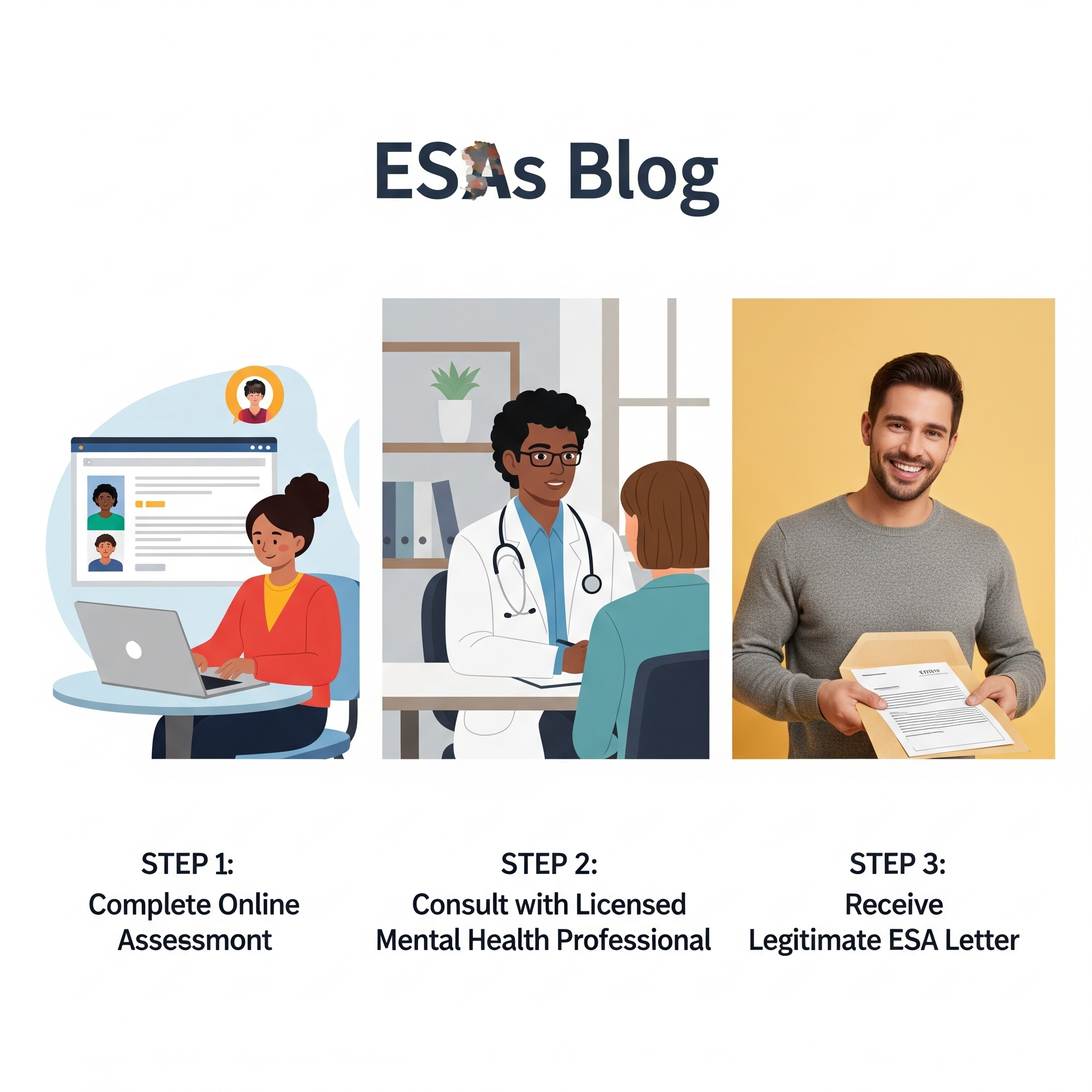For individuals managing mental health conditions, the presence of an Emotional Support Animal (ESA) can be profoundly beneficial, offering comfort and alleviating symptoms. Under the Fair Housing Act (FHA), individuals with disabilities, including mental health disabilities, are often entitled to reasonable accommodations that allow them to keep their ESAs in housing with “no pet” policies or breed/size restrictions. However, understanding the proper procedures for requesting this accommodation from your landlord is crucial for a smooth and respectful process. This comprehensive guide, brought to you by CertifyESA, your trusted partner in obtaining legitimate ESA and PSD letters, will walk you through each step.
Understanding Your Rights Under the Fair Housing Act (FHA)
Before initiating the request, it’s essential to understand your rights under the FHA. This federal law prohibits discrimination in housing based on disability, race, color, national origin, religion, sex, familial status, or disability. According to the U.S. Department of Housing and Urban Development (HUD) (n.d.), a person with a disability includes individuals with a physical or mental impairment that substantially limits one or more major life activities. An ESA can be considered a reasonable accommodation under the FHA if it provides emotional support that alleviates one or more of the symptoms associated with the individual’s disability.
Step-by-Step Guide to Requesting ESA Accommodation
Follow these steps to navigate the process of requesting ESA accommodation from your landlord effectively:
1. Obtain a Legitimate ESA Letter:
- Action: The cornerstone of your request is a legitimate ESA letter from a licensed mental health professional (LMHP). This letter serves as official documentation of your need for an ESA due to your mental health disability.
- Key Information in the Letter:
- The LMHP’s license information, including their license number, type, and issuing state.
- A statement that you have a mental health disability that substantially limits one or more major life activities.
- A recommendation that the presence of your specific animal is necessary to alleviate one or more of the symptoms associated with your disability.
- The LMHP’s signature and date.
- CertifyESA’s Role: CertifyESA facilitates the process of connecting you with licensed mental health professionals who can assess your needs and, if appropriate, issue a legitimate ESA letter that complies with legal requirements.
2. Review Your Lease Agreement:
- Action: Carefully review your current lease agreement to understand the existing pet policies. Note any clauses related to pets, fees, breed restrictions, or size limitations.
- Understanding Lease Terms: While the FHA can override “no pet” policies and certain restrictions for ESAs, understanding your lease provides context for your request.
3. Prepare Your Formal Written Request:
- Action: It’s crucial to submit your request in writing to your landlord or property management company. This creates a clear record of your communication and the date of your request.
- Content of Your Request Letter:
- Your Contact Information: Include your full name, address of the property, and contact details (phone number and email address).
- Statement of Disability and Need for Accommodation: Clearly state that you have a mental health disability and that your animal provides emotional support that alleviates one or more symptoms of your disability. Avoid disclosing specific details of your condition; the letter from your LMHP provides the necessary verification.
- Enclose Your ESA Letter: Attach a copy of your legitimate ESA letter from a licensed mental health professional (obtained through CertifyESA or your own provider).
- Reference the Fair Housing Act (FHA): Briefly mention that you are requesting a reasonable accommodation under the Fair Housing Act due to your disability.
- Information About Your ESA: Provide a brief description of your animal, including its type (e.g., dog, cat), breed (if applicable), and name. You can also mention that your ESA is well-behaved and does not pose a direct threat to the safety of others or cause substantial physical damage to the property.
- Proposed Accommodation: Clearly state that you are requesting an exception to the property’s “no pet” policy or any applicable breed/size restrictions to allow you to keep your ESA in your residence.
- Offer to Discuss: Express your willingness to discuss your request further and provide any additional information if needed.
- Professional and Respectful Tone: Maintain a polite and respectful tone throughout the letter.
- Date and Signature: Sign and date your letter.
4. Submit Your Request to Your Landlord:
- Action: Send your written request and the attached ESA letter to your landlord or property management company through a method that provides proof of delivery, such as certified mail with return receipt requested or email with a read receipt. Keep a copy of the letter and the delivery confirmation for your records.
5. Be Prepared for Your Landlord’s Response:
- Landlord’s Responsibilities: Under the FHA, landlords are required to engage in a good-faith interactive process with tenants who request reasonable accommodations. They may ask for verification of your disability and the necessity of the ESA, which your legitimate ESA letter should provide.
- Permissible Inquiries: Landlords can typically ask for:
- Confirmation that you have a disability (which is established by the LMHP’s letter).
- Confirmation that your animal provides emotional support that alleviates one or more of the symptoms associated with your disability (also addressed in the LMHP’s letter).
- Impermissible Inquiries: Landlords cannot ask for specific details about your mental health condition or demand access to your medical records beyond the ESA letter. They also cannot inquire about the specific tasks an ESA performs, as ESAs, unlike service animals, are not trained to perform specific tasks.
6. Engage in Open Communication:
- Action: Be open and responsive to your landlord’s inquiries. Provide any reasonable additional information they may request, while being mindful of your right to privacy regarding your medical history.
- Maintain a Positive Dialogue: Aim for a constructive and cooperative dialogue to reach a mutually agreeable solution.
7. Understand Potential Limitations and Exceptions:
- Direct Threat and Substantial Damage: The FHA does not protect ESAs that pose a direct threat to the safety of others or would cause substantial physical damage to the property. However, this assessment must be based on the animal’s specific behavior and history, not on breed stereotypes.
- Undue Financial and Administrative Burden: In rare cases, a landlord might be able to deny a reasonable accommodation if it would impose an undue financial and administrative burden. However, this is a high legal bar to meet and is unlikely to apply in most ESA situations.
- Owner-Occupied Buildings with Four or Fewer Units: The FHA may not apply to owner-occupied buildings with four or fewer units in some circumstances. However, it’s crucial to verify local and state laws, as they may offer broader protections.
8. Know Your Recourse if Your Request is Denied:
- Action: If your legitimate request for ESA accommodation is unreasonably denied, you have the right to file a complaint with HUD.
- Filing a Complaint: You can file a complaint online through the HUD website or by mail. HUD will investigate your claim and take appropriate action if discrimination is found.
- Seek Legal Counsel: You may also consider seeking legal advice from a fair housing organization or an attorney specializing in disability rights.
The Importance of a Legitimate ESA Letter from CertifyESA
Obtaining a legitimate and compliant ESA letter from a licensed mental health professional is the most critical step in successfully requesting ESA accommodation. CertifyESA is committed to providing a secure and reliable platform to connect you with qualified LMHPs who understand the legal requirements and the significant role ESAs play in supporting mental well-being. Our streamlined process ensures you receive the documentation you need to assert your rights under the Fair Housing Act with confidence.
Conclusion: Advocate for Your Needs with Confidence
Requesting ESA accommodation from your landlord is a process that requires understanding your rights, proper documentation, and clear communication. By following these steps and securing a legitimate ESA letter through CertifyESA, you can confidently advocate for your needs and ensure that your emotional support animal can continue to provide the comfort and support you rely on in your home. Remember to maintain a respectful dialogue with your landlord and be prepared to address any legitimate concerns they may have. Your well-being and the presence of your ESA are important, and the Fair Housing Act is in place to protect your right to reasonable accommodations.
Reference:
U.S. Department of Housing and Urban Development. (n.d.). Fair Housing Act. Retrieved from [Insert relevant HUD webpage URL about the Fair Housing Act here]





